The tutorial shows how to use the MAXIFS function in Excel to get the maximum value with conditions.
Traditionally, when you ever needed to find the highest value with conditions in Excel, you had to build your own MAX IF formula. While not a big deal for experienced users, that might present certain difficulties for novices because, firstly, you should remember the formula's syntax and, secondly, you need to know how to work with array formulas. Luckily, Microsoft has recently introduced a new function that lets us do conditional max an easy way!
Excel MAXIFS function
The MAXIFS function returns the largest numeric value in the specified range based on one or more criteria.
The syntax of the MAXIFS function is as follows:
Where:
- Max_range (required) - the range of cells where you want to find the maximum value.
- Criteria_range1 (required) - the first range to evaluate with criteria1.
- Criteria1 - the condition to use on the first range. It can be represented by a number, text or expression.
- Criteria_range2 / criteria2, …(optional) - additional ranges and their related criteria. Up to 126 range/criteria pairs are supported.
This MAXIFS function is available in Excel 2019, Excel 2021, and Excel for Microsoft 365 on Windows and Mac.
As an example, let's find the tallest football player in our local school. Assuming the students' heights are in cells D2:D11 (max_range) and sports are in B2:B11 (criteria_range1), use the word "football" as criteria1, and you will get this formula:
=MAXIFS(D2:D11, B2:B11, "football")
To make the formula more versatile, you can input the target sport in some cell (say, G1) and include the cell reference in the criteria1 argument:
=MAXIFS(D2:D11, B2:B11, G1)
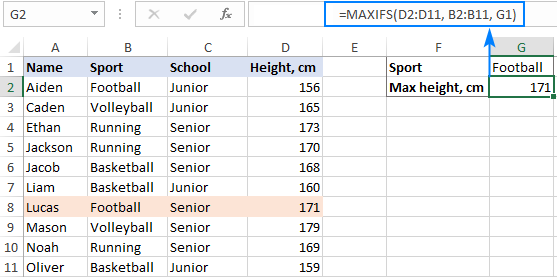
Note. The max_range and criteria_range arguments must be of the same size and shape, i.e. contain the equal number of rows and columns, otherwise the #VALUE! error is returned.
How to use MAXIFS function in Excel - formula examples
As you have just seen, the Excel MAXIFS is quite straightforward and easy to use. However, it does have a few little nuances that make a big difference. In the below examples, we will try to make the most of conditional max in Excel.
Find max value based on multiple criteria
In the first part of this tutorial, we created a MAXIFS formula in its simplest form to get the max value based on one condition. Now, we are going to take that example further and evaluate two different criteria.
Supposing, you want to find the tallest basketball player in junior school. To have it done, define the following arguments:
- Max_range - a range of cells containing heights - D2:D11.
- Criteria_range1 - a range of cells containing sports - B2:B11.
- Criteria1 - "basketball", which is input in cell G1.
- Criteria_range2 - a range of cells defining the school type - C2:C11.
- Criteria2 - "junior", which is input in cell G2.
Putting the arguments together, we get these formulas:
With "hardcoded" criteria:
=MAXIFS(D2:D11, B2:B11, "basketball", C2:C11, "junior")
With criteria in predefined cells:
=MAXIFS(D2:D11, B2:B11, G1, C2:C11, G2)
Please notice that the MAXIFS function in Excel is case-insensitive, so you needn't worry about the letter case in your criteria.
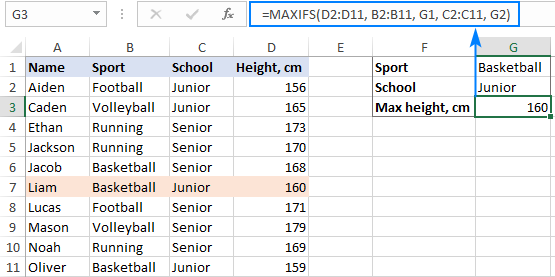
In case you plan to use your formula on multiple cells, be sure to lock all the ranges with absolute cell references, like this:
=MAXIFS($D$2:$D$11, $B$2:$B$11, G1, $C$2:$C$11, G2)
This will ensure that the formula copies to other cells correctly - the criteria references change based on the relative position of the cell where the formula is copied while the ranges remain unchanged:

As an extra bonus, I will show you a quick way to extract a value from another cell that is associated with the max value. In our case, that will be the name of the tallest person. For this, we will be using the classic INDEX MATCH formula and nest MAXIFS in the first argument of MATCH as the lookup value:
=INDEX($A$2:$A$11, MATCH(MAXIFS($D$2:$D$11, $B$2:$B$11, G1, $C$2:$C$11, G2), $D$2:$D$11, 0))
The formula tells us that the name of the tallest basketball player in junior school is Liam:
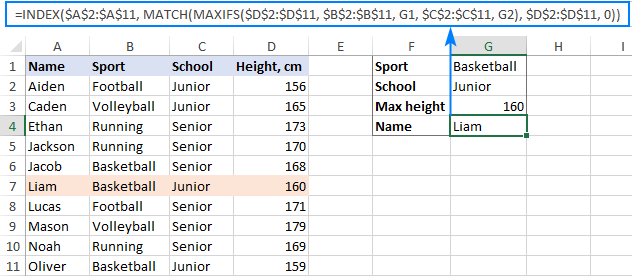
Excel MAXIFS with logical operators
In situation when you need to evaluate numeric criteria, use logical operators such as:
- greater than (>)
- less than (<)
- greater than or equal to (>=)
- less than or equal to (<=)
- not equal to (<>)
The "equal to" operator (=) can be omitted in most cases.
Usually, choosing an operator is not a problem, the trickiest part is to build criteria with the correct syntax. Here's how:
- A logical operator followed by a number or text must be enclosed in double quotes like ">=14" or "<>running".
- In case of a cell reference or another function, use the quotes to begin a string and an ampersand to concatenate the reference and finish the string off, e.g. ">"&B1 or "<"&TODAY().
To see how it works in practice, let's add the Age column (column C) to our sample table and find the maximum height among the boys aged between 13 and 14. This can be done with the following criteria:
Criteria1: ">=13"
Criteria2: "<=14"
Because we compare the numbers in the same column, criteria_range in both cases is the same (C2:C11):
=MAXIFS(D2:D11, C2:C11, ">=13", C2:C11, "<=14")
If you do not want to hardcode the criteria in the formula, input them in separate cells (e.g. G1 and H1) and use the following syntax:
=MAXIFS(D2:D11, C2:C11, ">="&G1, C2:C11, "<="&H1)
The screenshot below shows the result:

Aside from numbers, logical operators can also work with text criteria. In particular, the "not equal to" operator comes in handy when you wish to exclude something from your calculations. For example, to find the tallest student in all sports excluding volleyball, use the following formula:
=MAXIFS(D2:D11, B2:B11, "<>volleyball")
Or this one, where G1 is the excluded sport:
=MAXIFS(D2:D11, B2:B11, "<>"&G1)
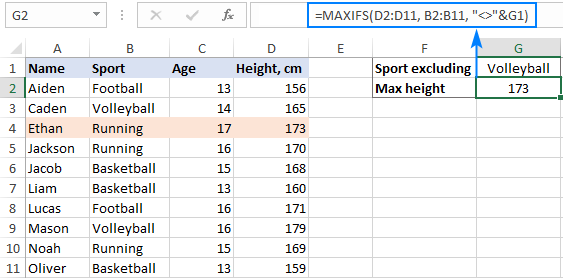
MAXIFS formulas with wildcard characters (partial match)
To evaluate a condition that contains a specific text or character, include one of the following wildcard character in your criteria:
- Question mark (?) to match any single character.
- Asterisk (*) to match any sequence of characters.
For this example, let's find out the tallest guy in game sports. Because the names of all game sports in our dataset end with the word "ball", we include this word in the criteria and use an asterisk to match any previous characters:
=MAXIFS(D2:D11, B2:B11, "*ball")
You can also type "ball" in some cell, e.g. G1, and concatenate the wildcard character with the cell reference:
=MAXIFS(D2:D11, B2:B11, "*"&G1)
The result will look as follows:
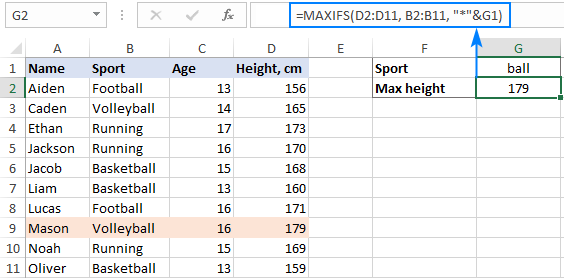
Get max value within a date range
Because dates are stored as serial numbers in the internal Excel system, you work with the dates criteria in the same manner as you work with numbers.
To illustrate this, we will replace the Age column with Date of Birth and try to work out the max height among the boys born in a particular year, say in 2004. To accomplish this task, we need to "filter" the birth dates that are greater than or equal to 1-Jan-2004 and less than or equal to 31-Dec-2004.
When building your criteria, it is important that you provide the dates in the format that Excel can understand:
=MAXIFS(D2:D11, C2:C11, ">=1-Jan-2004", C2:C11, "<=31-Dec-2004")
Or
=MAXIFS(D2:D11, C2:C11, ">=1/1/2004", C2:C11, "<=12/31/2004")
To prevent misinterpretation, it makes sense to utilize the DATE function:
=MAXIFS(D2:D11, C2:C11, ">="&DATE(2004,1,1), C2:C11, "<="&DATE(2004,12,31))
For this example, we will type the target year in G1, and then use the DATE function to supply the dates:
=MAXIFS(D2:D11, C2:C11, ">="&DATE(G1,1,1), C2:C11, "<="&DATE(G1,12,31))

Note. Unlike numbers, dates should be enclosed in quotation marks when used in the criteria on their own. For example:
=MAXIFS(D2:D11, C2:C11, "10/5/2005")
Find maximum value based on multiple criteria with OR logic
The Excel MAXIFS function is designed to test the conditions with the AND logic - i.e. it processes only those numbers in max_range for which all the criteria are TRUE. In some situations, however, you may need to evaluate the conditions with the OR logic - i.e. process all the numbers for which any of the specified criteria is TRUE.
To make things easier to understand, please consider the following example. Supposing you want to find the maximin height of the guys who play either basketball or football. How would you do that? Using "basketball" as criteria1 and as "football" criteria2 won't work, because Excel would assume that both criteria should evaluate to TRUE.
The solution is to make 2 separate MAXIFS formulas, one per each sport, and then use the good old MAX function to return a higher number:
=MAX(MAXIFS(C2:C11, B2:B11, "basketball"), MAXIFS(C2:C11, B2:B11, "football"))
The screenshot below shows this formula but with the criteria in predefined input cells, F1 and H1:

Another way is to use a MAX IF formula with OR logic.
7 things to remember about Excel MAXIFS
Below you will find a few remarks that will help to improve your formulas and avoid common errors. Some of these observations have already been discussed as tips and notes in our examples, but it might be helpful to get a short summary of what you've already learned:
- The MAXIFS function in Excel can get the highest value based on one or multiple criteria.
- By default, Excel MAXIFS works with the AND logic, i.e. returns the maximum number that meets all of the specified conditions.
- For the function to work, the max range and criteria ranges must have the same size and shape.
- The SUMIF function is case-insensitive, i.e. it does not recognize the letter case in text criteria.
- When writing a MAXIFS formula for multiple cells, remember to lock the ranges with absolute cell references for the formula to copy correctly.
- Mind the syntax of your criteria! Here are the main rules:
- When used on their own, text and dates should be enclosed in quotation marks, numbers and cell references should not.
- When a number, date or text is used with a logical operator, the whole expression must be enclosed in double quotes like ">=10"; cell references and other functions must be concatenated by using an ampersand like ">"&G1.
- MAXIFS is only available in Excel 2019 and Excel for Office 365. In earlier versions, this function is not be available.
That's how you can find the maximum value in Excel with conditions. I thank you for reading and hope to see you on our blog soon!
Download practice workbook:
Excel MAXIFS formula examples (.xlsx file)
 by
by
39 comments
I'm trying to figure out the correct formula to find the maximum number from one column (e.g., Tiers), that is associated with each value/string from another column (e.g., Locations). For example, in the first case, what is the maximum Tier value for locations that start with '002'? It seems that the issue is how to do a string search on an array. I've tried using MAXIFS but I can't get the correct results. In the example below, the maximum value for Tier for any Location that starts with '002' would be 3.
Location Tier MaxTier for Location starting with 'Location value'
002 0 3
002.001 1 3
002.001.001 2 2
002.001.002 2 3
002.001.002.001 3 3
002.002 1 2
002.002.001 2 2
I appreciate any ideas!
Hello Larry!
If I understand your task correctly, pay attention to the following paragraph of the article above: MAXIFS formulas with wildcard characters (partial match).
For example:
=MAXIFS(B1:B7,A1:A7,"002*")
You can also find useful information in this article: Excel wildcard: find and replace, filter, use in formulas.
Thanks, Alexander! The wildcard did the trick. Also, the reference you cited gave me the idea to expand the equation to incorporate the cell reference with the '&" to make the formula work for all the rows. Really appreciate your help with this ("&!").
Hi there, I seem to not be having much luck with this method for a similar scenario - it seems to ignore my If criteria.
I have a set of data for different Locations and Cases, for a given location and case I want to find the minimum force.
Data is in Columns A:D, then my formula for finding the position of the minimum value is in I4 =MATCH(MINIFS(D:D,B:B,I2,C:C,I3),D:D,0)
I have specified Case 3 and Location 2 therefore the min force should be item 17(**) however it is returning item 5(*).
Paste from spreadsheet below, sorry its not very clear but you cannot add screenshots to comments:
Position Case Location Force
1 1 1 -716 Case 3
2 1 2 -619 Location 2
3 1 3 -860 Position of min 5
4 1 1 -1023
5* 1 2 -884
6 1 3 -1229
7 2 1 -842
8 2 2 -716
9 2 3 -752
10 2 1 -1203
11 2 2 -1023
12 2 3 -1074
13 3 1 -663
14 3 2 -716
15 3 3 -722
16 3 1 -947
17** 3 2 -1023
18 3 3 -1031
19 4 1 -650
20 4 2 -665
21 4 3 -685
22 4 1 -929
23 4 2 -950
24 4 3 -979
Hi! Based on your criteria, the MINIFS function finds the minimum value: -1023. MATCH function searches for this value in column D and finds it in cell D5. Since your table has a header row, the return value is the position number 5. For a correct search, use the criteria you used for the minimum value search in the MATCH formula as well. In addition, do not do a full-column search.
Based on this information, the formula could be as follows:
=MATCH(1,(D2:D100=MINIFS(D2:D100,B2:B100,I2,C2:C100,I3))*(B2:B100=I2)*(C2:C100=I3),0)
You can also find useful information in this article: Excel INDEX MATCH with multiple criteria - formula examples.
You will get a result of 17.
HELLO,
how to find , MAXIFS WITH Multiple max range and multiple sheets with one criteria
Hello! To create a dynamic reference to more than one worksheet, you can use the INDIRECT function. If you use the MAXIFS function, you will get the maximum value by condition on each of the worksheets. To find the largest of these values, use the MAX function. Here is an example formula:
=MAX(MAXIFS(INDIRECT({"Sheet1","Sheet2"}&"!D1:D100"), INDIRECT({"Sheet1","Sheet2"}&"!A1:A100"), "Criteria"))
Hello,
Thank you for great explanation and examples all works fine but I found and issue with MAXIFS. Maybe this is an Excel at all problem.
Please help.
in column C:C I have long numbers but it cannot be as real number, actually it is a text, sometimes those numbers must contain zeroes before which is important, that's why it is text format, e.g.:
323212505100042446125030
323212505100042414163030
323212505100042496668030
323212505100042488935030
323212505100042585535030
323212505100042586329030
323212505100042414163030
I am looking for max value in another column which is E:E - simple number value to find higher one or what ever it can be:
300
400
500
0
600
9999
800
My input to find is 323212505100042414163030 in cell I5
and this value exists 2 times in column C:C
Formula which I use is as below (of course I know "=" isn't required but just in case for sure):
=MAXIFS( E:E, C:C, "="&H5 )
Situation looks like never mind where in column E:E I put for example 99999 (which will be max value) it show me always those max value in any row. I found out Excel is changing input parameter from column C:C and probably search input (cell H5) to number scientific format and lost last digits. In this case it looks like below - all numbers is the same:
323212505100042000000000
323212505100042000000000
323212505100042000000000
323212505100042000000000
323212505100042000000000
323212505100042000000000
323212505100042000000000
That's why never mind where I put highest number it always show me first one because C:C contain the same value (after changing it to wrong number format and replacing last 9 digits to zeroes).
If all of this Long ID values I change with letter prefix before it - problem not exists, Excel do not changing format internally just using it as a Text (example like "a323212505100042414163030")
Help please, how can I skip this bug or problem.
Why Excel is doing this? I found out this 'conversion' problem after long time almost drop all my hairs.
Thank you
Hi! Excel has a limit of no more than 15 digits in a number. When you type a number that contains more than 15 digits into a cell in Microsoft Excel, Excel changes all of the digits after the fifteenth digit to zeros.
You can try splitting a long number into 2 numbers. For example, 3232125051000 and 42446125030. Read more: Excel substring functions to extract text from cell.
=--LEFT(A1,13)
=--MID(A1,14,15)
Double minus is used to convert text to a number.
I am trying to get the most frequent name in a list based off another column being "read". I have used this formula that will determine the most repeated text based of that column alone =INDEX(A2:A11,MODE.MULT(MATCH(A2:A11,A2:A11,0))) but I want it to only count the most repeated text only if column G within the same row has the text "read" . Column G is based of a dropdown list of the following: Read, Reading, TBR, Wishlist.
Hi! To find the most frequent text in a column, use the COUNTIF function and select the position with the maximum value using the MAX function. In older versions of Excel, write this formula as an array formula.
=INDEX($A$2:$A$20, MATCH(MAX(COUNTIF($A$2:$A$20,$A$2:$A$20)), COUNTIF($A$2:$A$20,$A$2:$A$20),0))
If you want to find the most frequent text with a criterion in another column, use the COUNTIFS function to count it.
=INDEX($A$2:$A$20, MATCH(MAX(COUNTIFS($A$2:$A$20,$A$2:$A$20,B2:B20,"read")), COUNTIFS($A$2:$A$20,$A$2:$A$20,B2:B20,"read"),0))
I am trying to calculate the longest waiting time for anyone under 5 years (0 - 4 Years) and then for anyone 5 years or older (5 - 17 Years).
The under 5 years worked fine: =MAX(IF(Table1[AGE]"4", Table1[WEEKS WAITED FROM REFERRAL DATE]))
Can anyone help?
THanks
Naomi
Hi! It's very hard to understand a formula that uses unique references to your data that I don't have. I will try to assume that the formula could look something like this:
=MAXIFS(D2:D11, C2:C11, ">=5", C2:C11, "<=17")
or
=MAX(IF((C2:C11>=5)*(C2:C11<=17), D2:D11))
C - age. D - weeks.
For more information, read article above and this guide: MAX IF in Excel to get highest value with conditions.
1 0 0 5
2 -10 0 5 6
3 -20 0 6 7
4 -30 0 7 8
5 -5 -50 9 10
6 -15 -50 10 11
7 -25 -50 11 12
8 -35 -50 12
9 0 -100 13
10 -10 -100 13 14
11 -20 -100 14 15
12 -30 -100 15 16
13 -5 -150
14 -15 -150
15 -25 -150
16 -35 -150
these are coordinates and answer
i want to find below nearest left and right coordinates
for example for 2 , left nearest below is 6 and right is 5
can i have equation .thank you.
Hi! Your task is not completely clear to me. Explain how you determine the nearest numbers. 6 and 5 meet several times.
I'm trying to use the formula maxifs(Sheet2!$A$2:A$21-A2, Sheet2!$A$2:A$21-A2, "<=0") but it doesn't work. Excel says there is a problem with this formula.
Hi! The problem is Sheet2!$A$2:A$21-A2. This is an invalid expression. I can't advise you as I don't know what you wanted to do. The MAXIFS function argument is a range of values, but not a formula. Please read the above article carefully.
Thanks for your reply. I'm trying the find the closest date to a specific date in cell A2 from the range Sheet2!A2:A21.
Hi! To get the closest date to a specific date in cell A2, use MIN function:
=INDEX(A3:A21, MATCH(MIN(ABS(A3:A21-A2)), ABS(A3:A21-A2),0))
I need a formula,To filter data for a list of students from different sections to find the highest score per section and give the name of the student with the grade and id.
I create this formula :
=VLOOKUP(MAX(FILTER(FILTER(A2:J221,(C2:C221=S6)*(A2:A221=S7),0),{0,0,0,0,1,0,0,0,0,0})),E2:J221,{1,3,5,4,6},0)
But the problem is that its not giving me the highest grade persection , its giving me the highest grade in all the sections.
Hi!
To find the maximum score for a condition, use the MAXIFS function instead of MAX. Read the recommendations above carefully.
If I need to find the highest grade per grade and per subject, what formula I can use ?
Thank you.
Hi!
Please re-check the article above since it covers your task.
If I have a list of students from different sections I need to find the highest score per section for two different subjects and give the name of the student with the grade. What formula? Can you help me pls.
Thank you
Hi!
To find the highest score, use recommendations from this article above. To find a name of the student with this highest score, use INDEX MATCH function. I don't have your data so I can't give you the formula. Follow the guidelines in these articles.
Hi! I'm trying to get the max Week value of one (1), based on the max values of both Year and Month (2029 and 1), for the three records below. The formula works as expected when there is only one range/criteria combination but returns the value zero (0), which means a record can't be found, as shown in the formula below.
Could you please provide a corrected MAXIFS and an explanation as to why my formula isn't working as expected.
Year,Month,Week
2028,1,2
2028,12,52
2029,1,1
=MAXIFS ([Week], [Year], MAX([Year]), [Month], MAX([Month]))
Hello!
The MAXIFS formula returns 0 because the maximum year (2029) and maximum month (12) are on different rows.
Use instruction - MAX IF formula with multiple criteria.
Try this formula -
=MAX(IF((Table1[Year]=MAX(Table1[Year]))*((MAX(Table1[Year])=Table1[Year])*Table1[Month]),Table1[Week]))
I hope my advice will help you solve your task.
Thanks for your prompt response and accurate formula! I thought that that was what was going on with my formula code.
If Microsoft doesn't have a function to does what I wanted to do, maybe they will create a DMaxIfs function that does that. Hopefully they are reading this.
Ultimately in the end, I needed something usable as a VBA code snippet. This morning I had a rethink and all I really needed was the Year and Week fields to get the max value for Week.
If I hadn't figured it out after frying too many brain cells, I would have definitely used your formula code and then wrote VBA code to that cell address. Here's what I came up with for Excel and VBA. Hopefully this helps someone down the road.
Worksheet formula...
=MAXIFS(TableRangeName[WeekRangeName],TableRangeName[YearRangeName],MAX(TableRangeName[YearRangeName]))
VBA code snippet...
Sub TablesAndFormulaAddressing()
Dim FY, RW As Integer
' Get Max values for records using named ranges
' TableRangeName not needed since named ranges are unique to the workbook
FY = WorksheetFunction.Max([YearRangeName])
RW = WorksheetFunction.MaxIfs([WeekRangeName], [YearRangeName], WorksheetFunction.Max([YearRangeName))
End Sub
What would the MAXIFS formula for the following example below look like?
1 Absent ("0" or "1" is displayed using [=IF((AND('Severity Rating'.I3="No",'Severity Rating'.I4="No",'Severity Rating'.I15="No")),"1","0")])
2 Mild ("2" is displayed using [=IF('Severity Rating'.I3="Yes";"2";"0")])
3 Moderate ("3" is displayed using [=IF('Severity Rating'.I4="Yes";"3";"0")])
4 Severe ("4" is displayed using [=IF('Severity Rating'.I5="Yes";"4";"0")])
I want to create a function to identify the max number (4 in this case) and sum all the severity ratings in each category (the above is just one category).
Thanks!
Hello!
Your formulas return text, not numbers. Instead of "1" use 1 and so on.
To find the sum of the ratings in a given category, use the SUMIF function instruction.
That worked!! Thank you!
If i want the value to be returned for multiple sheets how this formula can be changed?
Hi!
What formula are you talking about and what data do you want to return?
Is it possible to find MAX difference (in numbers) between 2 columns i.e. In Jan 2022 Mark's number was 170 and Philip's number was 172. Now in Feb 2022 Mark's number is 200 and Philip's number is 220. I want a formula to find the max difference between Jan & Feb numbers like here Philip's numbers increased by 48 numbers (highest between 2) and it should return Philip's name.
Hi!
You have not specified how your data is written. For example, the formula might look like this:
=IF(A3-A2 > B3-B2,A1,B1)
If this is not what you wanted, please describe the problem in more detail.
Index / Maxifs will return the first record found with matching value ... If Ethan height was 171.. Maxifs formula becomes irrelevant as Index will return Ethan's name
isn't it ?
Trying to figure out how to write a MAX IF condition to cover all scenarios.
If a calculated value is a negative number, then default to '0'. If calculated value is a positive number, then display a whole number that doesn't round up ('20.8' should display as '20'). The formulas below work independently, but haven't been able to blend the two into a single formula.
=MAX(0,220-D12)*E12
=INT((220-D12)*E12)
Hello!
If I understand your task correctly, the following formula should work for you:
=IF(A2>0,ROUNDDOWN(A2,0),0)
You can learn more about ROUNDDOWN function in Excel in this article on our blog.
Thank you for the section on Find maximum value based on multiple criteria with OR logic.